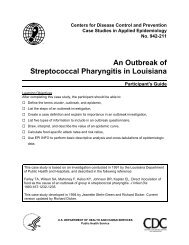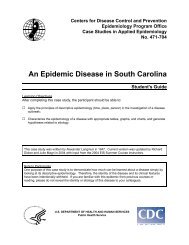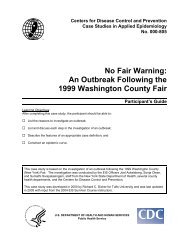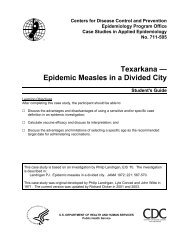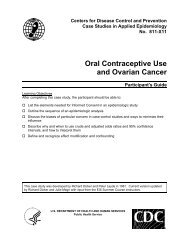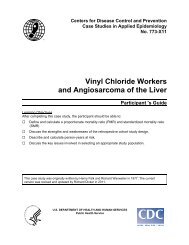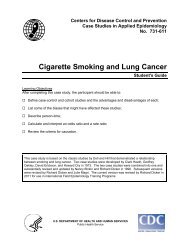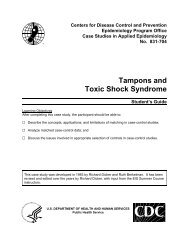Create successful ePaper yourself
Turn your PDF publications into a flip-book with our unique Google optimized e-Paper software.
Centers for Disease Control and Prevention<br />
Case Studies in Applied Epidemiology<br />
No. 701-X11<br />
An Outbreak of Jaundice in a<br />
Rural County (“<strong>West</strong> <strong>Branch</strong> <strong>Hepatitis</strong>”)<br />
Learning Objectives<br />
After completing this case study, the participant should be able to:<br />
Define the term “epidemic,”<br />
Create a case definition and explain its importance in an outbreak investigation,<br />
Draw and interpret an epidemic curve,<br />
Calculate an attack rate,<br />
Characterize an outbreak by time, place, and person.<br />
Participant's Guide<br />
This case study was originally written by Virgil Peavy and Fred Hoesly in 1970, based on an<br />
investigation by Stephen Schoenbaum. The current version was revised and updated by Richard Dicker<br />
in 2011.<br />
U.S. DEPARTMENT OF HEALTH AND HUMAN SERVICES<br />
Public Health Service
CDC: <strong>West</strong> <strong>Branch</strong> <strong>Hepatitis</strong> — Participant's Guide (701-X11) Page 2<br />
PART I<br />
On Friday, May 17, 1968, the Center for Disease<br />
Control (CDC) in Atlanta was contacted by the<br />
Michigan State Health Department. In the<br />
telephone conversation, state officials told CDC<br />
staff that, since April 30, 32 cases of jaundice<br />
had been reported to the district health<br />
department in the city of <strong>West</strong> <strong>Branch</strong>, Ogemaw<br />
County, Michigan.<br />
Question 1:<br />
Can you conclude that this is an epidemic? If not, what additional information would you<br />
seek from the state officials to help you determine whether this is an epidemic?<br />
Question 2:<br />
Other than an epidemic, what else could prompt an increase in reported cases?
CDC: <strong>West</strong> <strong>Branch</strong> <strong>Hepatitis</strong> — Participant's Guide (701-X11) Page 3<br />
Ogemaw County, located in central Michigan,<br />
had a 1960 population of 9,680. The area is<br />
predominantly rural, divided between farmland<br />
and forest. The county seat is <strong>West</strong> <strong>Branch</strong> city,<br />
with 2,025 residents. The only two other<br />
communities of notable size in Ogemaw County<br />
are Rose City (population 435) and Prescott<br />
(population 308). The remaining area is divided<br />
into 14 townships. Most of the permanent<br />
residents represent the lower or lower-middle<br />
socioeconomic class. In the summer there is<br />
also a large tourist population.<br />
A 60-bed community hospital in <strong>West</strong> <strong>Branch</strong><br />
serves Ogemaw County and the surrounding<br />
areas. Five physicians, including one surgeon,<br />
practice in <strong>West</strong> <strong>Branch</strong>. An osteopath practices<br />
in Rose City and another practices in Prescott.<br />
In the 12 months prior to April, 7 cases of<br />
jaundice had been reported to the District Health<br />
Department. Four of these 7 cases had<br />
occurred in one family outbreak in the previous<br />
August. The remaining 3 cases were scattered<br />
in time, and bore no apparent relationship to one<br />
another. The Health Department has not<br />
experienced any recent changes in personnel or<br />
surveillance methods.<br />
***<br />
The cases of illness were characterized by acute<br />
onset of fever, anorexia, nausea, malaise, and<br />
abdominal discomfort, followed by jaundice. The<br />
earliest case had onset of symptoms on April 2.<br />
All except 6 of the 32 cases occurred in<br />
residents of Ogemaw County.<br />
Epidemic assistance was requested by state<br />
health officials. On Sunday, May 19, an<br />
Epidemic Intelligence Service (EIS) officer left for<br />
Ogemaw County to meet with state and local<br />
officials and begin the investigation.<br />
Question 3:<br />
What causes of jaundice should be considered by the epidemiologists investigating this<br />
apparent outbreak? In other words, what can cause outbreaks of jaundice?
CDC: <strong>West</strong> <strong>Branch</strong> <strong>Hepatitis</strong> — Participant's Guide (701-X11) Page 4<br />
Question 4:<br />
What case definition would you use? (Remember, no tests for hepatitis A or hepatitis B<br />
existed at the time.)<br />
Question 5:<br />
How would you conduct case finding?
CDC: <strong>West</strong> <strong>Branch</strong> <strong>Hepatitis</strong> — Participant's Guide (701-X11) Page 5<br />
PART II<br />
By May 19, when the first investigator from CDC<br />
arrived in <strong>West</strong> <strong>Branch</strong>, 39 cases of jaundice<br />
had been reported to the district health<br />
department. These case reports came from the<br />
medical practitioners in the area. The<br />
investigators decided to define a case as:<br />
Illness in any person who resided in Ogemaw<br />
County or visited Ogemaw since January 1968<br />
who had either of the following criteria:<br />
(1) acute onset of jaundice; or<br />
(2) a compatible clinical syndrome and<br />
laboratory evidence of hepatitis (SGPT<br />
greater than twice normal) occurring on or<br />
after April 1.<br />
Investigators identified additional cases by<br />
periodically calling each physician's office, and<br />
by asking reported case-patients about other<br />
people they knew with jaundice. In addition,<br />
since the epidemic generated considerable<br />
public concern, several cases were reported<br />
spontaneously by local residents. As a result, 24<br />
more cases were reported by June 1 among<br />
Ogemaw County residents. An additional 13<br />
cases were reported in persons residing outside<br />
Ogemaw County.<br />
All of these patients had symptoms and/or<br />
laboratory values compatible with hepatitis. One<br />
case without jaundice was uncovered; this<br />
patient had a compatible clinical syndrome and<br />
an SGPT of 1180 units.<br />
As a next step, the investigators attempted to<br />
interview all of the reported case-patients. Two<br />
interviewers conducted all of the interviews in the<br />
patients' homes using a standard questionnaire.<br />
Patients were asked about the date of onset and<br />
symptoms of illness, previous exposure to<br />
hepatitis, visits outside the community, and<br />
history of receiving blood products. In addition,<br />
all other family members were interviewed<br />
regarding recent illnesses and the administration<br />
of gamma globulin. The patients and their<br />
families were also asked about specific sources<br />
of water and food and attendance at large<br />
gatherings or public places. At the time of the<br />
interview, a tap water sample was taken from<br />
each home for bacteriologic analysis.<br />
A line listing of the 76 reported cases is provided<br />
in Table 1. Tables 2 and 3 provide additional<br />
data about Ogemaw County.<br />
Question 6:<br />
What techniques would you use to report the descriptive epidemiology of this outbreak?
CDC: <strong>West</strong> <strong>Branch</strong> <strong>Hepatitis</strong> — Participant's Guide (701-X11) Page 6<br />
Table 1. Line Listing of Cases of Jaundice, Ogemaw County, Michigan, April – May, 1968<br />
Case # Age Sex Ogemaw Township / City County Jaundice? Date of Onset<br />
1 11 M -- Iosco Y 4- 2<br />
2 16 F Rose Township Ogemaw Y 4- 3<br />
3 34 M <strong>West</strong> <strong>Branch</strong> Township Ogemaw Y 4- 6<br />
4 10 F -- Iosco Y 4- 8<br />
5 37 F -- Iosco Y 4-12<br />
6 15 M Mills Ogemaw Y 4-28<br />
7 46 M <strong>West</strong> <strong>Branch</strong> Township Ogemaw Y 4-30<br />
8 21 F <strong>West</strong> <strong>Branch</strong> City Ogemaw Y 5- 1<br />
9 14 M <strong>West</strong> <strong>Branch</strong> Township Ogemaw Y 5- 1<br />
10 34 F -- Wayne Y 5- 2<br />
11 13 M Edwards Ogemaw Y 5- 2<br />
12 43 M <strong>West</strong> <strong>Branch</strong> Township Ogemaw Y 5- 2<br />
13 14 M Ogemaw Ogemaw Y 5- 3<br />
14 22 M -- Isabella Y 5- 3<br />
15 37 M Churchill Ogemaw Y 5- 3<br />
16 5 F <strong>West</strong> <strong>Branch</strong> Township Ogemaw Y 5- 3<br />
17 11 F Hill Ogemaw Y 5- 3<br />
18 19 M <strong>West</strong> <strong>Branch</strong> Township Ogemaw Y 5- 4<br />
19 14 F <strong>West</strong> <strong>Branch</strong> Township Ogemaw Y 5- 4<br />
20 35 F <strong>West</strong> <strong>Branch</strong> Township Ogemaw Y 5- 4<br />
21 11 F <strong>West</strong> <strong>Branch</strong> Township Ogemaw Y 5- 4<br />
22 14 M Rose Township Ogemaw Y 5- 4<br />
23 14 M Ogemaw Ogemaw Y 5- 4<br />
24 45 F -- Arenac Y 5- 5<br />
25 15 M Ogemaw Ogemaw Y 5- 5<br />
26 12 M <strong>West</strong> <strong>Branch</strong> Township Ogemaw Y 5- 5<br />
27 50 M <strong>West</strong> <strong>Branch</strong> Township Ogemaw Y 5- 5<br />
28 56 M -- Marion, IN Y 5- 6<br />
29 50 M Churchill Ogemaw Y 5- 6<br />
30 8 F -- Wayne Y 5- 6<br />
31 11 M <strong>West</strong> <strong>Branch</strong> Township Ogemaw Y 5- 7<br />
32 15 M <strong>West</strong> <strong>Branch</strong> City Ogemaw Y 5- 7<br />
33 18 F <strong>West</strong> <strong>Branch</strong> Township Ogemaw Y 5- 7<br />
34 14 M Churchill Ogemaw Y 5- 7<br />
35 15 M <strong>West</strong> <strong>Branch</strong> Township Ogemaw Y 5- 8<br />
36 30 M Logan Ogemaw Y 5- 8<br />
37 20 F <strong>West</strong> <strong>Branch</strong> City Ogemaw Y 5- 9<br />
38 14 F <strong>West</strong> <strong>Branch</strong> City Ogemaw Y 5- 9<br />
39 17 M Edwards Ogemaw Y 5- 9<br />
40 15 M <strong>West</strong> <strong>Branch</strong> Township Ogemaw Y 5- 9<br />
CDC: <strong>West</strong> <strong>Branch</strong> <strong>Hepatitis</strong> — Participant's Guide (701-X11) Page 7<br />
Table 1 (cont). Line Listing of Cases of Jaundice, Ogemaw County, Michigan, April – May, 1968<br />
Case # Age Sex Ogemaw Township / City County Jaundice? Date of Onset<br />
41 37 F Edwards Ogemaw Y 5- 9<br />
42 49 F -- Oakland Y 5-10<br />
43 16 M Churchill Ogemaw Y 5-10<br />
44 19 M -- Arenac Y 5-10<br />
45 29 F <strong>West</strong> <strong>Branch</strong> City Ogemaw Y 5-10<br />
46 5 M <strong>West</strong> <strong>Branch</strong> City Ogemaw Y 5-10<br />
47 8 F <strong>West</strong> <strong>Branch</strong> City Ogemaw Y 5-11<br />
48 15 F Churchill Ogemaw Y 5-11<br />
49 14 M Hill Ogemaw Y 5-11<br />
50 16 M Logan Ogemaw Y 5-11<br />
51 46 M -- Hartford, CT Y 5-12<br />
52 16 M <strong>West</strong> <strong>Branch</strong> City Ogemaw Y 5-12<br />
53 19 M <strong>West</strong> <strong>Branch</strong> Township Ogemaw Y 5-12<br />
54 15 M Ogemaw Ogemaw Y 5-12<br />
55 10 F <strong>West</strong> <strong>Branch</strong> City Ogemaw Y 5-12<br />
56 6 M Edwards Ogemaw N 5-12<br />
57 20 M Mills Ogemaw Y 5-12<br />
58 43 M Edwards Ogemaw Y 5-12<br />
59 15 F Churchill Ogemaw Y 5-12<br />
60 12 F Logan Ogemaw Y 5-12<br />
61 14 M <strong>West</strong> <strong>Branch</strong> Township Ogemaw Y 5-13<br />
62 34 M <strong>West</strong> <strong>Branch</strong> Township Ogemaw Y 5-13<br />
63 15 F Churchill Ogemaw Y 5-13<br />
64 30 M <strong>West</strong> <strong>Branch</strong> City Ogemaw Y 5-13<br />
65 16 M <strong>West</strong> <strong>Branch</strong> Township Ogemaw Y 5-13<br />
66 15 M <strong>West</strong> <strong>Branch</strong> City Ogemaw Y 5-14<br />
67 15 M <strong>West</strong> <strong>Branch</strong> City Ogemaw Y 5-14<br />
68 16 M <strong>West</strong> <strong>Branch</strong> City Ogemaw Y 5-14<br />
69 16 M <strong>West</strong> <strong>Branch</strong> City Ogemaw Y 5-14<br />
70 18 F <strong>West</strong> <strong>Branch</strong> City Ogemaw Y 5-15<br />
71 13 M -- Roscommon Y 5-16<br />
72 12 M <strong>West</strong> <strong>Branch</strong> Township Ogemaw Y 5-18<br />
73 11 M -- Iosco Y 5-18<br />
74 22 F Churchill Ogemaw Y 5-20<br />
75 15 F Edwards Ogemaw Y 5-24<br />
76 14 M <strong>West</strong> <strong>Branch</strong> City Ogemaw Y 5-26
CDC: <strong>West</strong> <strong>Branch</strong> <strong>Hepatitis</strong> — Participant's Guide (701-X11) Page 8<br />
Question 7:<br />
Using the data in Table 1, characterize the outbreak by time. (Suggestion: Use a<br />
method that distinguishes Ogemaw County residents from non-residents.)<br />
Question 8:<br />
Describe and interpret your findings. What inferences can you make regarding the<br />
probable time of exposure of most of the cases?
CDC: <strong>West</strong> <strong>Branch</strong> <strong>Hepatitis</strong> — Participant's Guide (701-X11) Page 9<br />
Table 2. Population of Ogemaw County by Age and Sex, 1960 U.S. Census<br />
Age group<br />
(years) Males Females Total<br />
0 – 4 525 511 1,036<br />
5 – 9 547 448 995<br />
10 – 14 540 447 987<br />
15 – 19 446 423 869<br />
20 – 24 238 254 492<br />
25 – 29 233 215 448<br />
30 – 34 213 222 435<br />
35 – 39 247 298 545<br />
40 – 44 271 276 547<br />
45 – 49 291 283 574<br />
50 – 54 263 270 533<br />
55+ 1,143 1,076 2,219<br />
Total 4,957 4,723 9,680<br />
Table 3. Population of Ogemaw County by Township and City, 1960 U.S. Census<br />
Township / City<br />
Total<br />
Churchill 610<br />
Cumming 344<br />
Edwards 609<br />
Foster 107<br />
Goodar 145<br />
Hill 519<br />
Horton 382<br />
Klacking 291<br />
Logan 378<br />
Mills 597<br />
Ogemaw 569<br />
Richland 704<br />
Rose City 435<br />
Rose Township 566<br />
<strong>West</strong> <strong>Branch</strong> City 2,025<br />
<strong>West</strong> <strong>Branch</strong> Township 1,399<br />
Total 9,680
CDC: <strong>West</strong> <strong>Branch</strong> <strong>Hepatitis</strong> — Participant's Guide (701-X11) Page 10<br />
Figure 1. Ogemaw County Townships and Cities, 1968
CDC: <strong>West</strong> <strong>Branch</strong> <strong>Hepatitis</strong> — Participant's Guide (701-X11) Page 11<br />
Table 4. Number of Cases and Attack Rates per 1,000 of Jaundice by Age and Sex, Ogemaw County,<br />
April–May 1968<br />
Age group Males Females Total<br />
(years) Cases Rate Cases Rate Cases Rate<br />
0 – 4 ______ ______ ______ ______ ______ ______<br />
5 – 9 ______ ______ ______ ______ ______ ______<br />
10 – 14 ______ ______ ______ ______ ______ ______<br />
15 – 19 ______ ______ ______ ______ ______ ______<br />
20 – 24 ______ ______ ______ ______ ______ ______<br />
25+ ______ ______ ______ ______ ______ ______<br />
Total ______ ______ ______ ______ ______ ______<br />
Question 9:<br />
Using the data in Tables 1 and 2 to complete Table 4, characterize the outbreak by<br />
person.<br />
Question 10: Characterize the outbreak by place by using the data in Tables 1 and 3 to display<br />
numbers of cases and rates in Figure 1.<br />
Question 11: Summarize your findings.<br />
Question 12: What hypotheses about the mode of transmission and source should be considered at<br />
this point?
CDC: <strong>West</strong> <strong>Branch</strong> <strong>Hepatitis</strong> — Participant's Guide (701-X11) Page 12<br />
PART III<br />
The configuration and duration of the epidemic<br />
curve suggested a common source of infection.<br />
By working backwards one incubation period<br />
from the bulk of cases, investigators estimated<br />
that exposure occurred at some time during the<br />
first 2 weeks in April. The outbreak appeared to<br />
center around <strong>West</strong> <strong>Branch</strong> and Churchill<br />
townships. The investigators considered<br />
possible sources such as municipal water;<br />
prepared foods which were available in local<br />
restaurants and groceries; milk; and clams or<br />
oysters.<br />
Because of the high attack rates among 10-19<br />
year olds, the investigators next focused their<br />
attention on the schools.<br />
Ogemaw County Schools<br />
Ogemaw County has four school districts, two of<br />
which are extensions from adjacent Iosco<br />
County. The largest district is the one served by<br />
the <strong>West</strong> <strong>Branch</strong> Public School, a single building<br />
complex located near downtown <strong>West</strong> <strong>Branch</strong><br />
with 1,525 pupils in kindergarten through grade<br />
12. Seventy percent of the pupils at the school<br />
use the school buses. <strong>West</strong> <strong>Branch</strong> City also<br />
has a Roman Catholic parochial school (St.<br />
Joseph) with 250 pupils, Grades 1 through 8.<br />
The parochial school students use the same<br />
school buses as the public school children.<br />
Both <strong>West</strong> <strong>Branch</strong> and St. Joseph schools have<br />
cafeterias and use the municipal water supply<br />
system. At the public school, children who<br />
attend kindergarten through grade 6 are not<br />
allowed to leave the campus for lunch. They<br />
may eat food prepared at the school cafeteria or<br />
may bring a lunch from home. Children in<br />
grades 7 through 12 may leave the school<br />
grounds during lunch hour. Since the school is<br />
only one block from the main street of <strong>West</strong><br />
<strong>Branch</strong>, many students go downtown for lunch<br />
each day.<br />
At the parochial school, students must eat lunch<br />
from the cafeteria or bring lunch from home; they<br />
are not allowed to leave the school grounds<br />
during lunch.<br />
Hale, Lincoln, and Jefferson schools are located<br />
in counties adjacent to Ogemaw County.<br />
Question 13: Would you have focused your investigation on the schools, given that about 25% of the<br />
cases were not of school age?
CDC: <strong>West</strong> <strong>Branch</strong> <strong>Hepatitis</strong> — Participant's Guide (701-X11) Page 13<br />
Table 5. School and Grade Among Jaundice Case-Patients, Ogemaw County and Surrounding Area,<br />
April–May, 1968<br />
Case # School Grade Case # School Grade<br />
1 Hale 5<br />
2 Rose City 11<br />
4 Hale 5<br />
6 Unknown Unknown<br />
9 <strong>West</strong> <strong>Branch</strong> 8<br />
11 <strong>West</strong> <strong>Branch</strong> 8<br />
13 <strong>West</strong> <strong>Branch</strong> 8<br />
16 <strong>West</strong> <strong>Branch</strong> K<br />
17 Hale 5<br />
19 <strong>West</strong> <strong>Branch</strong> 9<br />
21 <strong>West</strong> <strong>Branch</strong> 5<br />
22 Rose City 8<br />
23 <strong>West</strong> <strong>Branch</strong> 8<br />
25 <strong>West</strong> <strong>Branch</strong> 10<br />
26 <strong>West</strong> <strong>Branch</strong> 7<br />
30 Lincoln Unknown<br />
31 <strong>West</strong> <strong>Branch</strong> 6<br />
32 <strong>West</strong> <strong>Branch</strong> 9<br />
33 <strong>West</strong> <strong>Branch</strong> 12<br />
34 <strong>West</strong> <strong>Branch</strong> 8<br />
35 <strong>West</strong> <strong>Branch</strong> 9<br />
38 <strong>West</strong> <strong>Branch</strong> 9<br />
39 <strong>West</strong> <strong>Branch</strong> 12<br />
40 <strong>West</strong> <strong>Branch</strong> 9<br />
43 Rose City 10<br />
44 <strong>West</strong> <strong>Branch</strong> 11<br />
46 <strong>West</strong> <strong>Branch</strong> K<br />
47 St. Joseph 2<br />
48 <strong>West</strong> <strong>Branch</strong> 10<br />
49 <strong>West</strong> <strong>Branch</strong> 7<br />
50 <strong>West</strong> <strong>Branch</strong> 9<br />
52 <strong>West</strong> <strong>Branch</strong> 10<br />
53 <strong>West</strong> <strong>Branch</strong> 11<br />
54 <strong>West</strong> <strong>Branch</strong> 10<br />
55 <strong>West</strong> <strong>Branch</strong> 4<br />
56 St. Joseph 1<br />
59 <strong>West</strong> <strong>Branch</strong> 10<br />
60 <strong>West</strong> <strong>Branch</strong> 4<br />
61 <strong>West</strong> <strong>Branch</strong> 8<br />
63 <strong>West</strong> <strong>Branch</strong> 10<br />
65 Prescott 10<br />
66 <strong>West</strong> <strong>Branch</strong> 10<br />
67 <strong>West</strong> <strong>Branch</strong> 10<br />
68 <strong>West</strong> <strong>Branch</strong> 10<br />
69 <strong>West</strong> <strong>Branch</strong> 10<br />
71 Jefferson Unknown<br />
72 <strong>West</strong> <strong>Branch</strong> 7<br />
73 Hale 5<br />
75 Prescott 9<br />
76 <strong>West</strong> <strong>Branch</strong> 9
CDC: <strong>West</strong> <strong>Branch</strong> <strong>Hepatitis</strong> — Participant's Guide (701-X11) Page 14<br />
Table 6. Number of Cases and Attack Rates per 1,000 of Jaundice by Grade, <strong>West</strong> <strong>Branch</strong> and St.<br />
Joseph Schools, Ogemaw County, April–May, 1968<br />
WEST BRANCH SCHOOL<br />
ST. JOSEPH SCHOOL<br />
Attack<br />
Attack<br />
Grade # Cases Enrollment Rate # Cases Enrollment Rate<br />
K 126 0<br />
1 128 37<br />
2 121 41<br />
3 107 37<br />
4 106 26<br />
5 120 30<br />
6 111 32<br />
7 110 26<br />
8 120 21<br />
9 143 0<br />
10 128 0<br />
11 112 0<br />
12 93 0<br />
TOTAL 36 1,525 23.6 2 256 7.8<br />
Question 14: Use the data in Table 5 to complete Table 6.<br />
Question 15: Do these data help to narrow the hypotheses?
CDC: <strong>West</strong> <strong>Branch</strong> <strong>Hepatitis</strong> — Participant's Guide (701-X11) Page 15<br />
PART IV<br />
Investigation of the <strong>West</strong> <strong>Branch</strong> School showed<br />
no association between occurrence of cases and<br />
the school cafeteria or other school-sponsored<br />
activities. Furthermore, about 25% of cases in<br />
school-age children occurred in students<br />
attending other schools in Ogemaw and<br />
surrounding counties. These students had no<br />
direct association with the <strong>West</strong> <strong>Branch</strong> School.<br />
Also, about a third of all cases occurred in the<br />
adult population. Therefore, the investigators<br />
turned their attention to possible common source<br />
exposures in the community.<br />
There was no evidence of exposure to<br />
parenteral inoculations, transfusions, shellfish, or<br />
hepatotoxic drugs.<br />
Residents of <strong>West</strong> <strong>Branch</strong> are served by<br />
municipal water and sewage systems. Most<br />
other Ogemaw County residents are served by<br />
individual wells and septic tanks.<br />
Locally consumed milk comes from numerous<br />
commercial sources, all of which distributed their<br />
products throughout the state.<br />
There are many establishments offering<br />
prepared foods in the area. Restaurants A and<br />
B are located in downtown <strong>West</strong> <strong>Branch</strong>.<br />
Restaurant A specializes in full-course meals<br />
and is patronized primarily by families and local<br />
civic groups. Restaurant B is a short-order cafe.<br />
Dairy Queen restaurants are located in Rose<br />
City and <strong>West</strong> <strong>Branch</strong> City. These are especially<br />
popular with teenagers, but are also visited by<br />
families in the evenings and on weekends. Both<br />
Dairy Queens are similar in size, items served,<br />
and utilization.<br />
The <strong>West</strong> <strong>Branch</strong> Bakery is located in downtown<br />
<strong>West</strong> <strong>Branch</strong> next to Restaurant A. It is the only<br />
bakery in Ogemaw County. It sells baked goods<br />
over-the counter and also distributes its products<br />
to some restaurants and food stores in Ogemaw<br />
and adjacent counties.<br />
Patients with onset of jaundice between April 28<br />
and May 26 were questioned about their<br />
exposure to these possible common sources.<br />
Because of the pattern of the epidemic curve,<br />
the questions were designed to ascertain<br />
exposure between April 1 and 14. Table 7<br />
shows the results for the 41 interviewed persons<br />
with jaundice who were between the ages 10<br />
and 19 years.<br />
Question 16: Interpret the information in Part IV and the data in Table 7.
CDC: <strong>West</strong> <strong>Branch</strong> <strong>Hepatitis</strong> — Participant's Guide (701-X11) Page 16<br />
Table 7. Frequency of Exposure to Water and Commercial Establishments in March and April Among 41<br />
Persons with Jaundice Aged 10-19 years, Ogemaw County, May, 1968<br />
Percent<br />
Exposure Yes No Unknown Known Exposed<br />
Restaurant A 15 25 1 36.6%<br />
Restaurant B 13 27 1 31.7%<br />
<strong>West</strong> <strong>Branch</strong> Dairy Queen 28 12 1 68.3%<br />
Rose City Dairy Queen 8 32 1 19.5%<br />
<strong>West</strong> <strong>Branch</strong> Bakery 37 3 1 90.2%<br />
<strong>West</strong> <strong>Branch</strong> Water 36 5 0 87.8%
CDC: <strong>West</strong> <strong>Branch</strong> <strong>Hepatitis</strong> — Participant's Guide (701-X11) Page 17<br />
PART V<br />
The results of the questionnaire on food and<br />
water sources revealed that the bakery and the<br />
municipal water were popular among the cases.<br />
Table 8 provides comparable exposure histories<br />
for 56 non-ill household members aged 10-19<br />
years.<br />
Table 8. Frequency of Exposure to Water and Commercial Establishments in March and April Among 56<br />
Non-ill Household Members Aged 10-19 years, Ogemaw County, May, 1968<br />
Percent<br />
Exposure Yes No Unknown Known Exposed<br />
Restaurant A 22 31 3 39.3%<br />
Restaurant B 15 39 2 26.8%<br />
<strong>West</strong> <strong>Branch</strong> Dairy Queen 39 17 0 69.6%<br />
Rose City Dairy Queen 6 50 0 10.7%<br />
<strong>West</strong> <strong>Branch</strong> Bakery 26 29 1 46.4%<br />
<strong>West</strong> <strong>Branch</strong> Water 51 4 1 91.1%<br />
Question 17: What do you conclude from Tables 7 and 8?<br />
Question 18: Based on what you know now, what actions are now appropriate (additional studies,<br />
close establishments, etc.)?
CDC: <strong>West</strong> <strong>Branch</strong> <strong>Hepatitis</strong> — Participant's Guide (701-X11) Page 18<br />
PART VI<br />
The two cases of jaundice that occurred in early<br />
April were both in food-handlers. One was a<br />
woman who worked at the Rose City Dairy<br />
Queen and who became ill on April 4. The other<br />
was a 34-year old physically- and mentallyhandicapped<br />
male who worked as a baker's<br />
assistant at the <strong>West</strong> <strong>Branch</strong> Bakery. He visited<br />
his physician on April 6, complaining of "vomiting<br />
and a cold." He went back to work, and on April<br />
7 he noticed that his urine was dark. He<br />
continued to work until April 11, when the<br />
diagnosis of infectious hepatitis was made. He<br />
did not return to work until April 23.<br />
Investigators considered the bakery to be the<br />
most likely source because of the results of the<br />
exposure histories among 10-19 year old cases<br />
and family members, and because of the<br />
identification of a possible source case. A new<br />
questionnaire focusing on specific bakery<br />
products was administered to the 63 cases who<br />
said they had eaten a bakery product between<br />
April 1 and April 14. The results of this survey<br />
are presented in Table 9.<br />
Table 9. Frequency of Exposure to Bakery Products in March and April among 63 Patients with Jaundice,<br />
Ogemaw County, May, 1968<br />
Percent<br />
Exposure Yes No Known Exposed<br />
Any glazed product 56 7 88.9%<br />
Doughnuts, glazed 39 24 61.9%<br />
Sweet roll, glazed 32 31 50.8%<br />
Doughnuts, plain 17 46 30.0%<br />
Bread 18 45 28.6%<br />
Cake 18 45 28.6%<br />
Cookies 11 52 17.5%<br />
Pie 11 52 17.5%<br />
Sweet roll, plain 10 53 15.9%<br />
Pastry 8 55 12.7%<br />
Question 19: Interpret the bakery questionnaire results in Table 9.
CDC: <strong>West</strong> <strong>Branch</strong> <strong>Hepatitis</strong> — Participant's Guide (701-X11) Page 19<br />
PART VII<br />
In many investigations, information from<br />
"unusual" cases reveals important clues or good<br />
supporting evidence. In this investigation, the<br />
case-patients who lived outside the county but<br />
who were thought to be part of the outbreak<br />
were therefore interviewed at length. Most had<br />
infrequent contact with establishments inside the<br />
county.<br />
Case 24 is a 45-year-old female school teacher<br />
who lives about 60 miles east of <strong>West</strong> <strong>Branch</strong> in<br />
Arenac County. Her only contacts with Ogemaw<br />
County were when she passed through <strong>West</strong><br />
<strong>Branch</strong> on March 20, April 5, and April 14 on the<br />
way to visit her father who lived on the other side<br />
of the state. On March 20, she stopped and had<br />
a cup of coffee in a <strong>West</strong> <strong>Branch</strong> restaurant. On<br />
April 5, she stopped and bought some glazed<br />
rolls and a coffee cake from the <strong>West</strong> <strong>Branch</strong><br />
Bakery. She did not stop on April 14. On May 5,<br />
1968, she became ill with hepatitis.<br />
Case 10 is a 34-year-old homemaker who lives<br />
in Wayne County, and Case 30 is her 8-year-old<br />
daughter. Case 42, a 49-year-old homemaker,<br />
is the sister-in-law of Case 10 and the aunt of<br />
Case 30. Both Case 10's family and Case 42's<br />
family own summer cottages in Ogemaw County<br />
(10 to 15 miles from <strong>West</strong> <strong>Branch</strong>). They went<br />
to their cottages on April 8, 9, and 10 to open<br />
them for the season. At no time did Case 42 or<br />
Case 30 go in or near the city of <strong>West</strong> <strong>Branch</strong>.<br />
On April 9, Case 42 took care of Case 10's<br />
children while Case 10 went into the city to<br />
conduct some business. At that time, Case 10<br />
bought some baked goods at the <strong>West</strong> <strong>Branch</strong><br />
Bakery to bring to the cottage for lunch. All three<br />
patients had the same kind of cream-filled rolls<br />
which were glazed. Case 10 became ill on May<br />
2, Case 30 became ill on May 6, and Case 42<br />
became ill on May 10. No other member of<br />
either family is known to have been ill since the<br />
April trip to open the cottages.<br />
Case 51, a 46-year-old white male who lives in<br />
Wethersfield, Connecticut, came to Ogemaw<br />
County to visit his mother on April 4, 5, and 6.<br />
On April 5 or 6, he went to <strong>West</strong> <strong>Branch</strong> and<br />
visited one of his friends, the owner of the<br />
bakery. The owner made him a present of<br />
glazed doughnuts. On May 13, 1968, Case 51<br />
became ill with hepatitis. Case 51's mother did<br />
not partake of the gift.<br />
Case 20 is a 35-year-old mother of six who<br />
purchased assorted glazed products at the<br />
bakery on April 6. She took the baked goods<br />
home, where she and her two older daughters<br />
ate some of them. Her two sons returned home<br />
later in the day and ate all but one glazed item.<br />
Still later, her 5-year-old twins came home and<br />
fought over the last pastry. To the victor went<br />
the pastry; the loser had none. One month later,<br />
the mother, her 2 daughters, 2 older sons, and<br />
the stronger twin became cases. The father and<br />
the other twin did not become ill.<br />
***<br />
The investigators visited the bakery. The <strong>West</strong><br />
<strong>Branch</strong> Bakery has served the region for 34<br />
years. The baker's assistant helped in several<br />
steps of the baked goods production. In<br />
particular, he was responsible for making and<br />
glazing doughnuts and for icing much of the<br />
pastry. Both glaze and icing may be kept for<br />
several days and old batches may be used to<br />
start new ones. Bakery items not sold in one<br />
day may be frozen for sale in the next one or two<br />
weeks. Therefore, contaminated foods could be<br />
available for consumption over a period of<br />
several days or weeks.<br />
Question 20: Would you close the bakery? Why or why not?
CDC: <strong>West</strong> <strong>Branch</strong> <strong>Hepatitis</strong> — Participant's Guide (701-X11) Page 20<br />
PART VIII — CONCLUSION<br />
Although none of the other bakery employees<br />
felt ill, a blood sample was taken from each<br />
employee. An SGPT (an enzyme test for liver<br />
function) was performed on each sample, and in<br />
each instance was within normal limits.<br />
Because the outbreak appeared to be over, and<br />
because no ill employees were identified through<br />
SGPT testing, the bakery was allowed to remain<br />
open. Leftover glaze and baked goods were<br />
discarded, and proper hygiene was emphasized.<br />
One investigator was skeptical that the bakery<br />
could account for the observed age-sex<br />
distribution of cases. Therefore, on June 3, he<br />
sat unobtrusively behind a counter in the bakery,<br />
and estimated the age and sex of each customer<br />
and noted the hour of the sale and the type of<br />
product purchased. The age distribution of<br />
bakery customers closely paralleled the age<br />
distribution of reported cases. Roughly equal<br />
numbers of males and females in each age<br />
group patronized the restaurant, in contrast to<br />
the 2:1 ratio among cases. The sex difference<br />
was more likely to have resulted from males<br />
eating more pastries than females (based on<br />
interviews from the household case-control<br />
study) than from a sex difference in patronage.<br />
Control Measures<br />
During this epidemic, between 7,000 and 8,000<br />
cc of gamma globulin (immune serum globulin)<br />
were administered. Gamma globulin was<br />
offered to all residents of the city of <strong>West</strong> <strong>Branch</strong><br />
and the immediately surrounding area, as well as<br />
to all household contacts of cases. The Health<br />
Department made a special effort to provide<br />
gamma globulin to school children, both in the<br />
<strong>West</strong> <strong>Branch</strong> public school and St. Joseph's<br />
parochial school. Mass administration of<br />
gamma globulin did not start until Tuesday, May<br />
14, 1968. The epidemic curve demonstrates<br />
that there was an abrupt decline in new cases<br />
after Wednesday, May 15, 1968. This decline<br />
cannot be wholly attributed to the widespread<br />
use of gamma globulin. No cases of infectious<br />
hepatitis with onset after May 26, 1968, were<br />
reported to the District Health Department.<br />
Undoubtedly, the mass administration of gamma<br />
globulin did play a role in suppression of<br />
secondary cases.<br />
REFERENCES<br />
1. Schoenbaum SC, Baker O, Jezek Z. Common-source epidemic of hepatitis due to glazed and iced<br />
pastries. Am J Epidemiol 1976;104:74-80.<br />
2. Roueche B. The <strong>West</strong> <strong>Branch</strong> Study. In: The Medical Detectives. New York: Truman Talley / New<br />
York Times Books, 1981. p 217-235 (chapter 14).




